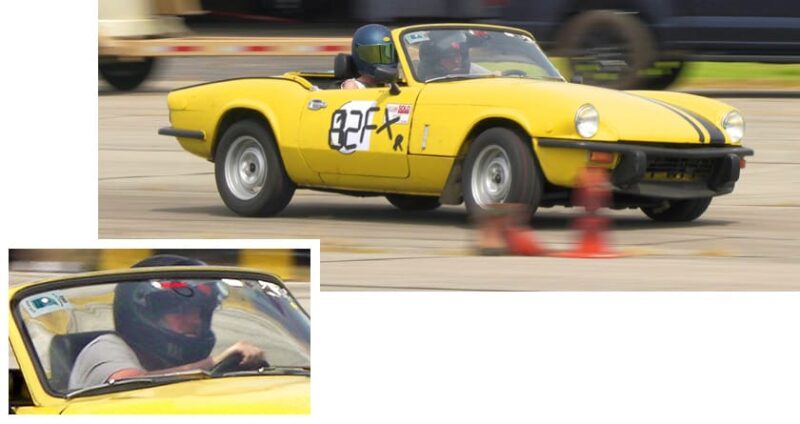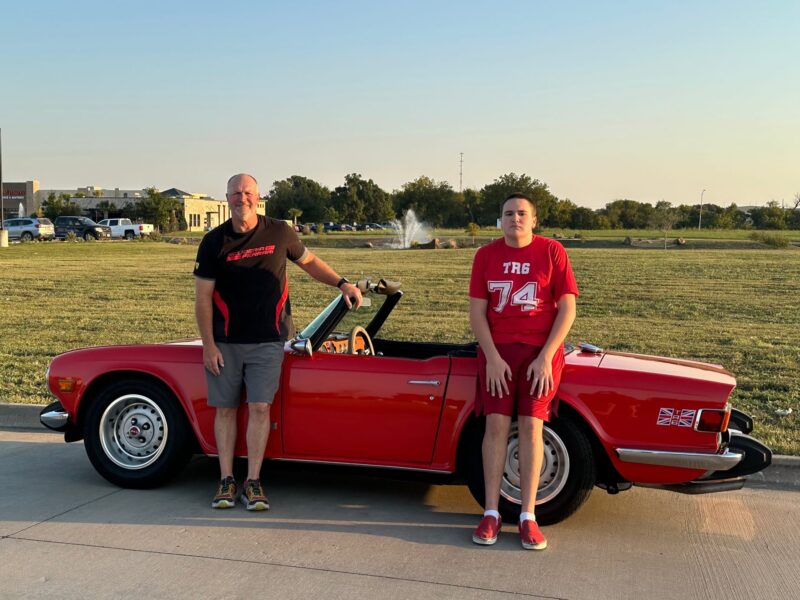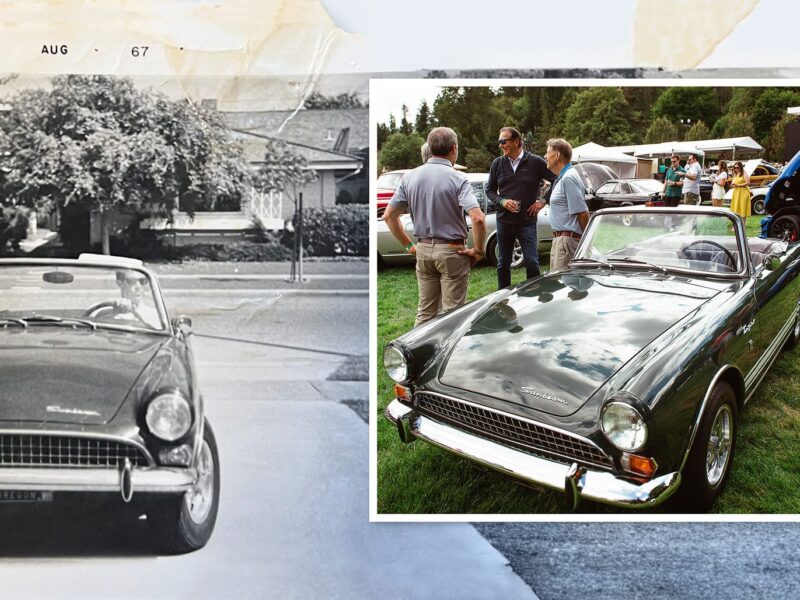
Stu Lasswell
When asked, “What is it that you love so much about British sports cars?” I think the answer is right there in the name: SPORTS car! Sport, by definition, usually means some form of competition. For automobiles, that means racing! And when it comes to the cars we all own, know, and love, most were mainstays of amateur auto racing in their day. Now, 50 to 75 years on, their days of racing glory are long past. Or are they? Today’s vintage racing scene is strong and growing, and an exciting way to relive those days… if you have the skill, mechanical ability, and the money to participate!
Realistically, these cars aren’t the only factor that’s 50 to 75 years old. That describes the age of the typical vintage British car enthusiast, too. So, where does that leave us, with our outdated sports cars and our Walter Mitty dreams of glory? Well, have you considered autocross?
Autocross is a legitimate form of auto competition that is almost as old as road racing. SCCA, the “big dog” in auto racing in America since WWII, has been holding events since the early ’50s. There used to be local club events in cities and towns all across the country, often in the parking lots of factories and shopping centers when they were closed on Sundays. (Remember those days?) Now SCCA and, to a lesser extent NASA, are the only organizations holding regular events, but their classing systems didn’t do us any favors, pitting our old cars against much newer cars. In response, a group within SCCA created a class specifically for older sports cars— Heritage Classic Street—in the hopes that having our own class would bring back the cars that filled the grids in days past. Unfortunately, that hasn’t happened, and the class has languished or been dropped due to lack of entries.
So, WHY AUTOCROSS? I think the real question is WHY NOT? Let’s take a look at the most common reasons that I’ve heard:
#1 I don’t want to damage my valuable old car!
Okay, that’s fair. But wrong! At all levels of autocross, safety is paramount. There are no other cars on the course, no hard objects to hit, and the cones are quite soft!
#2 But what if I break something?
True, something could break… you will be “pushing it.” But, the stress that could break that “weak link” could also break on your next “spirited” drive through the twisties. I’d rather have that worn or weak part fail in an open parking lot than on a mountain curve! That being said, I’ve never broken anything on an autocross course.
#3 I’ll embarrass myself! I’m old, the car’s old, I don’t know what I’m doing!
Honestly, you probably will be slow. Experience is the only answer. There’s usually a novice class, so you won’t be alone. Coaching is available. Be open to instruction, and just try to beat your previous time! Your car is old and probably underprepared. Don’t expect to win. Odds are you will get nothing but positive comments and praise for bringing it out! Most car people love and respect the classics!
So much for the potential downside of autocross. What’s the upside?
#1 You WILL become a better, safer driver.
Do you know the handling limits of your car? They are probably higher than you realize. And your skills? Probably not as good as you think! In an emergency, most drivers panic, grip the wheel and slam on the brakes. When you really know what you and your car can do, you can react quickly and often drive around the hazard. You don’t know the car’s (or your own) limits until you exceed them… and that should be done in safe and controlled conditions.
#2 You will know your car better.
You will come to recognize just what your car is communicating, be it through the steering wheel, the pedals, and the seat of your pants. You get a better feel for your tires’ adhesion limits, the right timing to shift, what your steering or braking input will do, good or bad. And you will come to recognize where you can make improvements. Like tires. Brakes. Sway bars.
#3 Hopefully you will see that the single greatest part to improve is that big nut behind the wheel!
If you continue in autocross without making any changes to your car, I guarantee that you will still see drastic improvements in your times! There is no greater factor in going faster than experience.
#4 Let’s not forget the most important upside… FUN!
There’s nothing quite like trying to get the most out of your car, challenging yourself to find that extra tenth of a second on that course. The drive is short, but oh so exhilarating! Your pulse will definitely be quickened with the adrenalin rush of that 30 to 60 seconds of intense driving.
I’ve been autocrossing my Triumph TR3 for almost 20 years now. I was ’crossing a modern Mini Cooper… a competitive car, and doing okay, but at Triumph meets like VTR Nationals and Triumphests (a Western U.S. regional event), I found that I much preferred tossing around the old TR3 to competing in the Mini. The Mini was very competent—a better car than I was a driver—but just not as fun. So, I set out to make the Triumph a more competent yet still fun autocrosser. Stickier tires on wider rims, competition springs and shocks, more negative camber and a stiff sway (anti-roll) bar. And most importantly, I believe, was regular, almost monthly participation in events. And now it’s pretty quick… for a TR3. An autocross-oriented build plus a lot of practice has brought me a modicum of success. The car now handles pretty darn well, but the trade-off is a stiffer ride and a less pleasant tourer. Something to consider.
But let’s be honest. It’s all relative. Let me give you an example: I drove my TR3 from central Arizona to San Rafael, California, for a Triumphest/ VTR meet. Won my class, and even set fastest time of day! Head swells! The very next weekend was an SCCA event in Phoenix. I believe my “raw time” standing was 143rd of about 200 entrants. Head deflates! Reality sets in: I’m pretty fast when competing with other old farts in equally old cars, but most cars are inherently faster, and I’m not getting any younger. Enjoy whatever success you can achieve.
So, bottom line. Autocross can lead to new levels of confidence and competence in all your driving. You can scratch that itch to compete, in a safe manner. You can enjoy the sport at whatever level of intensity you wish. You can take your enjoyment of British sports cars to a new arena, beyond the car show and touring, and start enjoying an element of what these fine automobiles were truly built for!
So, where can you find information? Here are some resources:
All marques: Sports Car Club of America (SCCA) www.scca.com Triumphs: Vintage Triumph Register (VTR) vintagetriumphregister.org Jaguar: Jaguar Club of North America (JCNA) www.jcna.com
There are many national and regional single- and multi-marque clubs that include MG, Austin Healey, Sunbeam, etc., but I can only name those that sponsor autocross nationally. Check with your local club, or the local sports car groups online, like BMW, Porsche, or Miata. Most will welcome “outsiders” for local events.

Mike Schlundt
My love for autocrossing is due to my dad, Tom Schlundt. In the ’70s he ran a ’62 356 Roadster and a couple Spitfires as well. In the late ’80s, when I was able to drive, he and I took a ’74 Spitfire through the cones, and together we wrenched on the car to give it more speed and better handling.
I became a truck driver and my time behind the wheel was primarily focused on hauling loads instead of pulling Gs for a couple of decades. But then “Otty” entered my life. Otty was a 1976 Spitfire my dad and I ran together. We made a ton of changes to the suspension, and swapped out the more fragile 1500 engine for a rugged 1300 small journal that could take our abuse—that is, until the bolts that held the flywheel came out and messed up the aluminum flywheel and crank.
We picked up a ’69 Spit with a healthy small journal 1300, sold the motor in Otty to buy another Spitfire with a rebuilt 1500, and with all these cars and parts we swapped things that broke, and ran whatever the SCCA approved depending on the ever-changing class regulations.
So, after a race, when confronted with another broken differential in Otty—and having another car laying around—I stripped the motor, trans, interior, and suspension in one night, went racing the next morning, and won my class. This is the beginning of “Ol Yeller,” my ’75 yellow Spitfire.
Ol Yeller is a mutt. She’s a 1500 with a built small journal 1300, breathing through SU4 carbs and a Euro exhaust. She has a single rail trans. The rear diff is a 4:11 with welded spider gears out of the ’69 and with the Mrk3 axle. I run a lot of negative chamber and a big front sway bar. Ol Yeller has GAZ shocks on all four corners with 300lb front springs; rear spring is a stock 1500 swing spring with a 2inch lowering block on the rear. To run in a street class, the car wears 13-inch Toyo Proxes R888s.
I learned about VTR Nationals in 2019 and was all excited to go out to Texas. I had gotten into a pissin’ match with a guy over which is a better motor, the 1500 or small journal 1300, but in the end I wasn’t able to go. I finally made the trip to VTR in 2021. Unfortunately, I lost my dad the year before and he never got to see Ol Yeller take FTD (Fastest Time of the Day).
I’ve learned with autocrossing that it’s more about skill and experience than horsepower. I love how some people underestimate my car, only to have their more powerful more expensive cars run several seconds slower than mine. Autocrossing brings out the competitive guy in me. And it keeps me coming back for more.

Tammy Frank
I have been riding as a passenger in a Spitfire for many years and many miles, alongside my husband Shawn. I bought him a project Spitfire for Christmas years ago and now I always know where to find him: in the garage. He built the car and named it Gertrude, but I helped him find parts, repair procedures, and even tools that he misplaced throughout the years.
This wasn’t my first autocross, as I have ridden with my husband in Gertrude, but this event turned out a little different. Shawn and I planned to participate, but we had overdrive issues on the road to VTR and, with a 600-mile drive home, we opted to not compete. Instead, I offered to take photos of the action. While we were walking through the paddock area, I said it would be fun to be a passenger. Mike Schlundt offered, I accepted, and then the hunt was on to find a helmet— and fast—since they were lined up and about ready to go.
As I was strapping on a borrowed helmet, Shawn laid it on thick, telling me there was an emergency seat fix very recently but he was unsure if it was the passenger or driver’s seat that broke. He also told me that sometimes Spitfire door latches come open, so I should hang on and buckle up. He finished his spiel by saying, “Don’t be scared, baby. Mike knows how to drive, so you won’t slide off the road.”
We had three runs around the course, hugging corners like only a Spitfire can. As soon as we came back into the paddock, my husband asked, “Did he scare you?” I replied, “Nah, not at all. Neither one of you has ever really scared me.” He knows I don’t scare easily, but I think he was hoping that I would lie this one time. Lol.
Oh, and Mike’s Spitfire had FTD with me in it.

Evan Moore
In the early 1960s, as a young teenager my father, Jim Moore, rode with a family friend in his highly modified Triumph TR3 and was bit by the LBC bug. Dad’s first Triumph TR3 came along in the late ’60s while he was in high school, followed by a Healey 3000 and a few MGs. In 1981 my little sister, April, was born and shortly after, this particular 1960 TR3 was purchased. It arrived at our house in a lightly rusted patina along with several boxes of spares. The car sat for nearly 20 years, and during that time it doubled as a step ladder for retrieving items from our garage attic.
Around 2003, as empty nesters, my parents finally started on the car’s restoration. Dad and our local hero Chuck McGuire (aka “Mr. Triumph”) rebuilt the entire driveline, engine, suspension, frame etc., and the body work was done at a local shop. The car boasts several performance mods including a 4:10 Detroit Locker rear end and those one-of-a-kind, homemade Triumph/Ford racing wheels Chuck created during his racing days in the 60’s.
This past year I convinced my sister to spend an entire week with me in Nashville, Indiana, at the VTR 2024.
It was her first time racing autocross and she won the women’s division overall and bested many of the men as well. I raced, too, and also do a few local SCCA weekend events. The car is always a big hit with the drivers and spectators. It is very sentimental to me and has made for many enjoyable memories. The plan is upon my departure I will leave the car to one of my sons… likely whichever one bribes me the most.
April Moore
A week-long trip to a VTR Convention was never really on my list of vacation ideas, that is, until my brother invited me to join him on an adventure. I jumped at the chance to spend some quality time with him and to see what all the fuss was about. In years past, my brother had usually taken our mother, so I was excited for my turn to see him in his element.
Although my brother and mother described previous conventions, I was a bit blind going in. My initial impression was “wow.” We rolled up to the lodge and a sea of Triumph cars. A sight that would make any enthusiast giddy.
The schedule was packed full of activities, but I think we would both agree the Autocross event was a highlight of VTR. Cones were set up. The course was walked. Helmets strapped on, and it was go time! I had driven the TR3 numerous times before my brother took ownership, but it had been about ten years since I was last behind the wheel. I was a bit nervous— never having run an autocross course before—but nonetheless thrilled to put my driving skills to the test. Plus, a few pointers from your brother never hurts.
Driving the TR3 hits all of your senses. Seeing nature’s beauty so close you can almost touch it. Smelling the husky aroma of freshly burned fuel. Hearing the guttural growl of a finely tuned engine. Holding the wheel and feeling the steady vibration of a well cared for machine. Tasting victory of a race run and won. There is something very special about this car. Through it we get to feel close to our dad, and there’s a sort of peace, too. A freedom.
All in all I’d say VTR was a success. It’s quite the community and a thrill to see everyone come together and share in the joy of these cars. It was especially cool to see my brother enjoying his pastime. I’m glad he asked his pain of a sister to join him in the fun. It meant the world to me, probably more than he’ll ever know. Love you brother.
Now for the next step: get my own car!








'Conquering The Cones The Case For Autocrossing' has 1 comment
March 13, 2025 @ 4:48 pm Jack Minot
On Long Island, New York there are three clubs who sponsor Autocross and accept any car regardless of make. Metro NY PCA, SCCA and BMWCCA.
Yes, you will be competing against newer cars, but my opinion is I am competing against myself. I want my times to be faster than my previous one!
I have never had such an adrenaline rush as I get when autocrossing. You come back to staging and your hands are shaking as you try to check your tire pressures. Don’t be embarrassed if you stink at first, we all did (I am probably 2 seconds slower that I should be) . JUST HAVE FUN! There are plenty of people willing to instruct.
I first started Autocrossing in 2009, at age 57, with my daughters 1991 Miata while I was restoring my 1979 Porsche. Finally halfway through 2010 I started using my 911. I have also used my 2006 base Mini Cooper 5 speed, which is a hoot! I sold my 1979 911in 2022 and purchase a base 2002 Porsche Carrera which I currently Autocross. I recently purchased a 1980 Triumph TR8 and I am in the process of upgrading the brakes, 4 wheel disc. I will be autocrossing this car too.
Jack